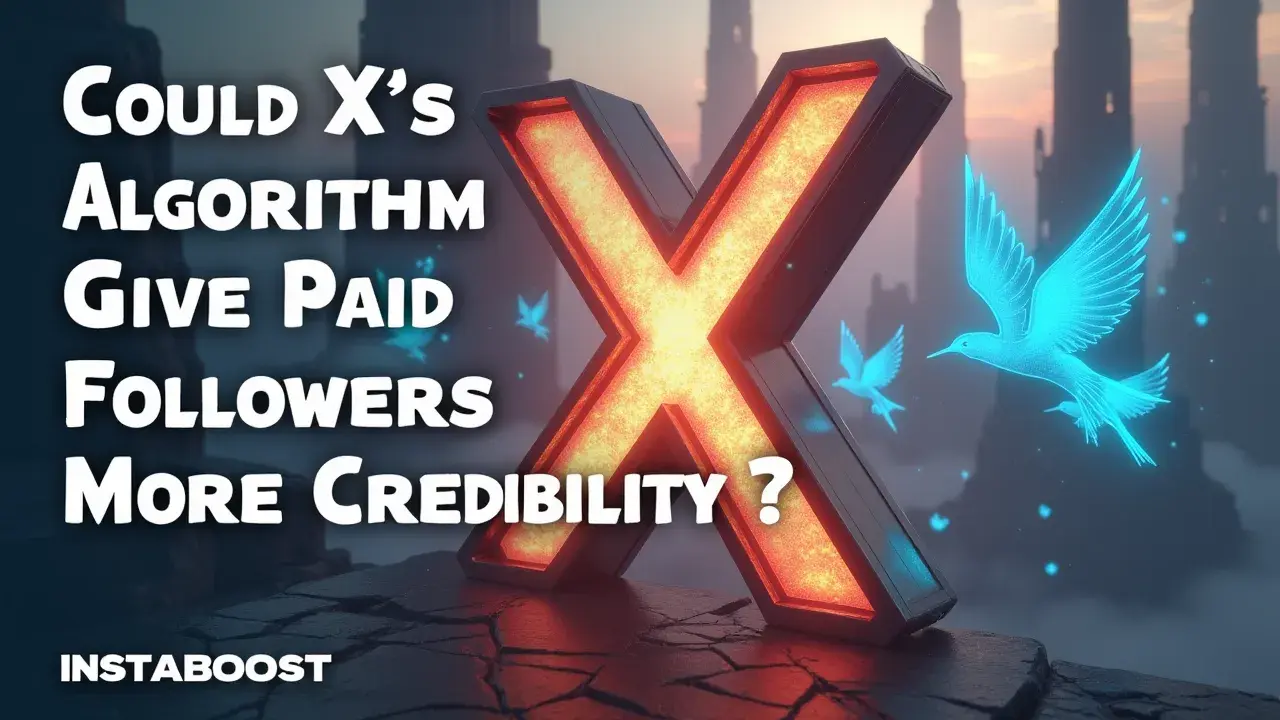Could X (Twitter)’s Algorithm Give Paid Followers More Credibility?
Paid followers can appear more credible under X’s algorithm when paired with authentic activity. A small engagement bump at publish can attract organic attention, especially if the topic already has momentum, but sustained credibility depends on steady posting and real content. Reviewing watch time and reply depth helps confirm whether the lift is sticking or fading. The smart path is timing early boosts and reinforcing them with consistent, relevant posts.
When “Paid” Becomes a Signal, Not a Stain
X’s algorithm doesn’t read character; it reads patterns. If credibility on the platform comes from how quickly engagement piles up, who’s connected to whom, and how steady those signals look, then paid followers and bought likes aren’t only vanity; they can become scaffolding for what the machine treats as “trust.” That’s the crux here: could X’s ranking system turn purchased engagement into a credibility boost, especially in those early minutes when it’s testing whether a post is worth showing?
The discovery layer – recommendations, For You, suggested follows – leans on things like interaction rate, audience overlap, and early saves or replies, and it’s why some justify a small nudge to scale your presence on Twitter as distribution rather than deceit.
The discovery layer – recommendations, For You, suggested follows – leans on things like interaction rate, audience overlap, and early saves or replies, and it’s why some justify a small nudge to scale your presence on Twitter as distribution rather than deceit.
If you seed enough of those cues, even if you paid for them, you might push the system to test your post in bigger pools. That’s where the messy middle shows up: not clean manipulation, not a pure merit test, but a gray zone where buying likes can shape the signal’s quality and timing. For brands and reporters, the math can feel practical: if the system weighs engagement more than where it came from, a small spend to “warm up” a post feels like distribution, not deception.
But it can bend the picture. Community cues – who follows whom, who comments first, which accounts vouch – turn into social proof the algorithm amplifies. Artificially boosting those cues can manufacture agreement that drowns out pushback and narrows what gets seen. The open question – and what we’ll dig into – is whether these tactics help a post get through the cold start or trigger a penalty once anomaly checks notice the pattern. On X, does buying likes buy a fairer test, or a faster flag?

When “Trust” Looks Like a Graph Problem
You don’t have to take my word for it – the pattern shows up on its own. Credibility on X isn’t a magic badge; it’s a shape the system recognizes: quick, clustered reactions from accounts that look like real people, happening again and again, across audiences that overlap. If you buy followers or likes and those accounts are thin – little activity, no mutuals, messy timelines – you’re teaching the system the wrong shape. The ranking model sees loose ties and noisy bursts, which read as gaming, not trust.
But if the paid layer behaves like normal activity – balanced replies and likes, saves, quote threads from semi-reliable accounts, engagement that comes in staggered waves instead of one spike – you’re giving the discovery system a rehearsal that looks close enough to real. That’s why some marketers call it bootstrapping: those first minutes matter, and a small seed can get you tested in larger pools, which is why they talk about how even small nudges can mimic organic lift more than blatantly trying to order x followers ever could. There’s a catch, though.
The same patterns that can lift you can also push you into a penalty box if the signals tilt the wrong way – sudden follower bumps from unrelated countries, synchronized comments, or engagement that never turns into longer sessions. X’s model likely looks beyond surface counts: overlap with known communities, the historical reliability of who engages, and whether your post sparks downstream actions like profile visits, follows, or time spent on a link. So “paid followers” only help if they fit the graph you’re already part of. The move isn’t buying volume; it’s buying signals that blend into how recommendations work. Do it poorly and you trip suppression. Do it well and you get a provisional shot in For You – just long enough to see if real people carry it forward. Not vanity so much as the plumbing underneath, with a half-life that runs out if nothing real shows up afterward.
Seeding the First Mile Without Poisoning the Well
Most pivots are overdue corrections. If X’s recommendation engine rewards early momentum, treat paid followers like starter fluid, not fuel. The goal is to compress the first 10 – 30 minutes when the system decides whether your post moves from your graph to For You. You need three things, in order: a small group that reliably reacts, a steady posting cadence so the system learns when you earn attention, and proof-of-life signals – saves, replies, profile clicks – that look like normal behavior. The twist is the credibility doesn’t come from the purchase as much as the way you set it up; I’ve seen teams quietly reference tools like scale likes for Twitter in planning docs without treating them as strategy.
Pair the post with a same-hour reply that adds context, tag one relevant source, and line up 5 – 15 real accounts for staggered, non-identical engagement. Paid followers help only if they look plausible: active timelines, some overlap with your network, usual dwell patterns. Anything that feels like a click farm will poison the pattern and cap reach. Treat it like ad verification: you’re buying a test, not an outcome. Set a hard budget, keep experiments to specific topics, and score each post on interaction rate and second-order actions. If quality slips, cut the subsidy before the system recasts your account as low-signal. That’s how you keep paid followers from eroding credibility while still nudging discovery: use them to guarantee a minimum viable burst, then let real audience behavior carry the ranking. If you’re asking whether paid followers give more credibility, the answer is conditional: precision, not volume, wins the first mile.
The Backfire Physics of “Borrowed” Credibility
Momentum is tricky because it covers up what’s not working. The pushback is simple: if X’s algorithm learns from engagement, it also learns from the people behind it, and paid followers leave marks. A burst of quick reactions can push you into For You, but the model immediately looks for staying power: does engagement widen beyond your circle, do people outside your network hang around, do replies branch into new parts of the graph?
When paid activity fails those second- and third-hop checks, your “credibility” settles into a familiar shape – thin session depth, shallow reply trees, and reach curves that spike early and fall off. So buying likes isn’t only a waste of money; it can train the system to downrank your handle later, the way staged applause or attempts to boost tweet views end up teaching the model to ignore you. There’s also the reputational side: power users and moderators can spot synthetic momentum, which undercuts the social proof you were trying to build. If you want algorithmic trust without poisoning it, keep any subsidy to the first mile and tie it to signals you can’t fake at scale: distinctive replies, quote-tweets from accounts people already trust, profile clicks that turn into follows, saves.
Treat paid followers like temporary scaffolding you take down, not a wall you lean on. Otherwise you end up telling the recommendation engine your audience can’t move on its own, which invites reach throttling or indifference. The credibility test on X isn’t whether you can spark; it’s whether the spark jumps gaps – into overlapping communities you didn’t prepay. That’s the part growth-hack threads skip, and why “buying credibility” often looks to the system like staged applause and.
Closing the Loop Without Locking Yourself In
This wasn’t a bow; it was a breadcrumb. If you want to see whether X’s algorithm gives paid followers extra credibility, close the loop cleanly and give yourself a kill switch. Treat subsidized reach like a controlled test: run it for two weeks, set a hard spend cap, and judge it on the behaviors the model actually weighs – saves, profile visits, follow-through reads – not likes. Keep the “starter fluid” group small and steady so you can see real lift, and match every boosted post with a true control at the same time and on the same topic. Watch what happens just off the main path: do replies bring in new handles, do dwell times hold outside your usual audience, does For You placement repeat once the paid “kindling” stops?
If it doesn’t spill into organic discovery, you’re training the system to rely on a crutch. The credibility risk isn’t moral; it’s mechanical. Engagement heuristics track who reacts, how fast, and how far that activity spreads, and even the temptation to “maximize tweet reach” can mask whether branching conversations actually take root. Paid followers can speed the first mile, but if they don’t spark branching conversations, the loop cools and, in some niches, you’ll see soft suppression.
The practical move: taper spend as soon as the audience widens and stays wide, rotate formats to stress-test what works, and post fewer, better pieces at predictable times so the model learns when you earn attention. Define failure up front – if paid momentum doesn’t turn into non-paid saves and cross-network replies within three cycles, cut it. That’s how you keep “paid followers” from becoming the product and keep your credibility – and your reach – earned. One metric to watch closely when you audit this: dwell time distribution…
What “Credibility” Really Buys You
The real question isn’t whether paid followers can fool X’s system; it’s whether those signals ever turn into trust. Algorithms don’t award credibility in one shot. They look for steady patterns. If a paid audience helps spark replies, quote chains, and saves that reach beyond your usual circle, the system reads that as proof that travels. If not, you’ve paid for noise. The early phase matters most: recency-weighted engagement and dwell time set your initial slope, but the next steps – profile visits, session depth, link reads – decide whether your reach widens or stalls.
That’s why buying likes is weak and subsidizing discovery is stronger; shallow clicks run out, and even people who track their reach with tools like Twitter visibility tools tend to see that actions which extend sessions build on themselves. In practice, credibility acts like a moving average of consistency and cross-network resonance. Make it testable: cap your spend, set clean controls, and track second-order effects like new-follower retention and topic expansion. If your boosts only bounce around the same small cluster, the model concludes “niche, not novel.” If they branch into new pockets and your unboosted twins lift too, you’ve shifted the graph without overfitting.
So if you’re a brand or a reporter, treat paid followers like infrastructure only if they help you create repeatable context – threads that teach, receipts that hold up, sources people save. Otherwise the credibility heuristic mirrors what you built: not the amount you rented, but the way you earned it. If you’re weighing X’s algorithm against paid followers, aim for durable signals and skip the glamour metrics; time spent on “algorithmic trust signals” will pay you back more than any follower count ever will.















